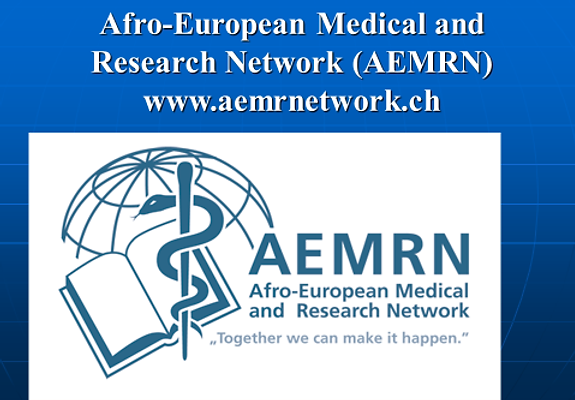The AEMRN diaspora: Bridging the digital divide and knowledge gap between southern and northern countries and between countries in the South through innovative digital technologies
CHARLES EDWARD LAHAI SENESSIE | 23 JUNE 2021 | ISSUE #15

Figure 1: The AEMRN logo.
Diaspora communities, comprising people who live outside their countries or continents of origin, are an increasingly influential force in sending societies, to which they contribute through the transfer of various resources (human, material and financial). Such efforts and initiatives seek to complement the efforts of the local governance and service delivery sectors in improving the lives of their less fortunate compatriots.
Hence it was with this vision that the Afro-European Medical and Research Network (AEMRN) was founded in 2006 in Bern, Switzerland by a Sierra Leonean migrant, Dr Charles Senessie. This diaspora community network, accredited by the United Nations Economic and Social Council (ECOSOC), aims to bridge the knowledge gap between southern and northern countries as well as between countries in the South.
Generating and sharing well-researched, evidence-based and locally accepted information is very inspiring, and when such information is converted into knowledge, it can be a powerful catalyst for enhancing and empowering behavioural and other changes. AEMRN members, including representatives from every continent around the world, strive to contribute their knowledge and experience to improve the quality of their work to benefit the people they interact with, irrespective of race, beliefs, and social affiliation.

Figure 2: AEMRN around the world.
Our vision for AEMRN is to serve as a platform wherein active professionals from disciplines such as education, public health and clinical medicine, engineering, nursing, midwifery, as well as from faith-based and civil society groups, can interact through various initiatives. Among these are web conferences where participants share skills and expertise, enhancing cross-cultural exchange and promoting global peace as we give back to our continents and countries of origin.
We promote the exchange of information, knowledge, skills and expertise for the benefit of communities in their local settings through various information and communications technology (ICT), hence empowering AEMRN members and others to think locally and act globally. As advanced innovative ICT approaches are turning the world into a ‘global village’, the AEMRN diaspora runs regular virtual education sessions to enable our proactive communities to benefit from the knowledge and experience of experts around the world.
Methodology
Alongside our colleagues in low- and middle-income countries, who keep expanding their knowledge to improve health, AEMRN members in the diaspora have been using simple low-resolution e-learning technologies such as Elluminate and advanced ones as Microsoft Teams, Zoom, WhatsApp, Skype, Webex, and the AEMRN/World Health Organisation (WHO) EZcollab Community of Practice to link individuals and institutions across countries. These colleagues are willing to learn from each other and share their knowledge so that together we address our challenges, especially in difficult times of pandemic outbreak such as Ebola and the currently raging COVID-19.
These tools have also been used for fundraising during the aforementioned and other humanitarian crises, including the mudslide that occurred in Sierra Leone in 2017, as well as the much needed psycho-social support after such disasters.

Figure 3: Supporting the younger generation in sharing and exchanging knowledge. Courtesy of AEMRN.
Hence, these tools greatly help improve the projects that we undertake in our communities, especially when we cannot easily go down to them, as we used to do through mobile clinics, nor physically interact with them. This way, we are still able to impart knowledge – one of the key social legacies we leave behind with them in complementing their efforts. We reach our diverse members in countries spreading over every continent in the world in synergising our efforts to maximise our outputs.
Monitoring and evaluation
The AEMRN team, led by a special unit for monitoring and evaluation, regularly reviews our efforts and interventions so that we learn from our challenges and build upon our successes for the betterment of the hard-to-reach communities. We also focus on the youths who are the future leaders of tomorrow – bearing in mind that youth is a state of mind and not a physical condition.
Conclusion
Our experiences continue to confirm that information sharing through innovative approaches, including North-South and South-South partnerships, can positively influence healthcare delivery and other humanitarian efforts, creating synergies to obtain the best results and ensure the sustainability of our initiatives. We encourage everyone to join and/or create similar initiatives as true to the motto of AEMRN, ‘Together we can make it happen’.

Charles Senessie
Dr Charles Senessie, MD (USL), PgDip Epidemiology (University of London), MSc Dermatology (University of South Wales, UK), and PhD (Health Sciences) international Health Researcher and Education (California, USA) and concluding second PhD Public Health Epidemiology, (Walden University, USA). He is a physician working for the Swiss Federal Government as well as in private practice and lives with his family in Bern, the Federal Capital of Switzerland. He has done multiple consultancies for the World Health Organisation (WHO) HQ, Geneva.
He is part of the diaspora originally from Sierra Leone, West Africa. Dr Senessie has been featured together with former President Obama, Rev Jesse Jackson, Oprah Winfrey and others in the book called The Most Influential Contemporary African Diaspora Leaders. In 2019 he was awarded the Top 100 Health Care Leaders Award by the USA International Forum on Advancements in Healthcare.

This article is part of the issue ‘Empowering global diasporas in the digital era’, a collaboration between Routed Magazine and iDiaspora. The opinions expressed in this publication are those of the authors and do not necessarily reflect the views of the International Organization for Migration (IOM) or Routed Magazine.





